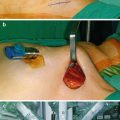Fig. 31.1
Calcium homeostasis – the role of PTH and 1,25-dihydroxyvitamin D
Classification of Hyperparathyroidism
Primary
Autonomous PTH secretion (single adenoma in 80–90 %, hyperplasia in 10–15 %, double adenoma in 2 %, and carcinoma <1 %), characterized by elevated serum calcium and PTH.
Primary hyperparathyroidism (PHPT):
The third most common endocrinological disease, present in up to 1 in 500 of the general population where it is predominantly a disease of postmenopausal women.
The prevalence of PHPT in women less than 40 years old is 10/100,000 and 190/100,000 in women over 65 years of age.
Multiple endocrine neoplasia (MEN) should be considered when a patient presents with PHPT below the age of 40 years with a family history of HPT.
A recently recognized variant of the disease is normocalcemic PHPT (Tordjman et al. 2004) where the level of PTH is elevated but the calcium level is normal or close to the upper limit of the normal range. It has yet to be determined if this form of PHPT is a precursor of hypercalcemic PHPT or a unique phenotype of PHPT. Patients with normocalcemic PHPT are usually identified during an investigation based on low bone mineral density.
Secondary
An appropriate physiological response to hypocalcemia characterized by elevated PTH and normal or low serum calcium concentrations.
Underlying possible causes of secondary hyperparathyroidism:
Gastrointestinal disorder (malabsorption)
Dietary vitamin D deficiency
Synthetic vitamin D deficiency secondary to renal insufficiency (also known as renal HPT)
Drugs (e.g., lithium, thiazides)
Tertiary
This is unique to patients who have undergone a successful renal transplantation. Rarely post transplantation (2 %), the preexisting secondary (renal) HPT develops into an inappropriate autonomous hypersecretion of PTH (akin to PHPT) resulting in hypercalcemia.
Clinical Manifestations
PHPT is most commonly associated with minimally symptomatic hypercalcemia that may be increasingly identified through the use of laboratory biochemical profiles that include calcium measurement (Silverberg and Bilezikian 1996).
The clinical manifestations of hyperparathyroidism are based on the effects of excess serum calcium. Elderly people are more sensitive to the symptoms even at lower levels of hypercalcemia. The classical signs and symptoms of hypercalcemia are much less commonly seen but include (Inzucchi 2004):
The effects of an increased level of PTH include (Bilezikian et al. 2005):
Signs and symptoms of hypercalcemia (Table 31.1).
Table 31.1
Manifestations of hypercalcemia
Renal manifestations: polyuria and polydipsia due to hypercalciuria and the decreased concentration capacity of the kidneys; nephrocalcinosis and/or nephrolithiasis; dRTA; renal insufficiency
Gastrointestinal manifestations: nausea, decreased appetite, vomiting, obstipation, peptic ulcer, pancreatitis
Other manifestations: fatigue, confusion, coma, musculoskeletal pain, decreased muscle strength, osteopenia or osteoporosis, hypertension, abnormal ECG findings (bradycardia, QT shortening)
Parathyroid bone disease.
Decreased bone mineral density (BMD), particularly in cortical bone rather than cancellous bone
Osteitis fibrosa cystica (rarely seen but includes):
Bone pain
Subperiosteal bone resorption (middle phalanges radial aspect)
Distal clavicular tapering
“Salt and pepper” appearance of the skull
Bone cysts
Brown tumors of the bones
Renal manifestations:
Decreased urinary concentrating ability leading to hypophosphatemia and hypomagnesemia
Nephrolithiasis (mainly calcium oxalate stones) and nephrocalcinosis
Proximal renal tubular acidosis (PTA)
Increased calcitriol level.
Hyperuricemia and gout.
Anemia: due to severe PHPT.
Cardiovascular diseases (Andersson et al. 2004): PHPT may be associated with hypertension, left ventricular hypertrophy and diastolic dysfunction, and increased vessel stiffness. It has also been suggested that vessel stiffness may be related to the severity of hyperparathyroidism.
Diagnosis and Differential Diagnosis of PHPT
Primary hyperparathyroidism is usually first suspected due to an elevated calcium concentration found as an incidental finding or through investigation of the symptoms of hypercalcemia.
Serum calcium (corrected to serum albumin) should be repeated, and previous calcium results should be reviewed, if available, to look for long-term asymptomatic hypercalcemia.
In 80–90 % of the patients with PHPT, there is an elevated serum concentration of PTH; however, 10–20 % of the patients have a PTH either mildly elevated or within the normal range (Nussbaum et al. 1987).
PHPT can be confirmed with the findings of:
Hypercalcemia (on two serum calcium measurements)
PTH elevated (or inappropriately at high end of reference range in the face of hypercalcemia)
Stay updated, free articles. Join our Telegram channel

Full access? Get Clinical Tree





